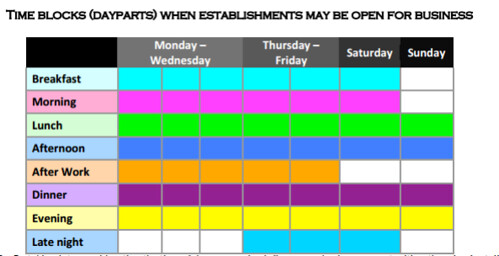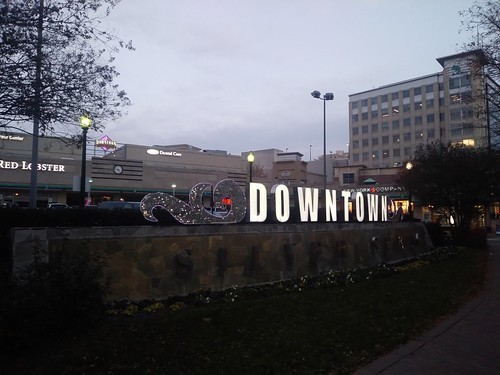Night time as a daypart and a design product
In the commercial district revitalization framework plans I did for a couple of small towns, I was proud of the concept I outlined of planning the district in terms of "dayparts" -- think how restaurants are organized around different times of day such as breakfast, happy hour, dinner, and late night -- and to plan the retail and programming mix accordingly.
This graphic isn't particularly scintillating but was included in the Cambridge, Maryland plan and the daypart planning concept is described in more detail on p. 18.

By taking into consideration the time of day as a major influence on business opportunities, the mix of retail, services, attractions, special events and other programming can be planned in a manner that maximizes patronage of the commercial district throughout the day and into the evening (p. 17).
A few minutes after I had the thought about how cities ought to employ lighted street signs more frequently ("More cities should have lighted street signs"), and having recently mentioned the Bath UK Bath City Centre Lighting Strategy, in keeping with thinking for awhile about "Night-time safety: rethinking lighting in the context of a walking community" (2014), and also recent media coverage in DC ("Does D.C. Need A 'Night Mayor' To Oversee City Nightlife?," Kojo Nnamdi Show, WAMU-FM/NPR) and New York City ("NYC Nightlife: City Hiring Night Mayor to Revive Scene," Fortune Magazine) about creation of Offices of Night Life, Night Mayors ("What Europe's 'Night Mayors' Can Teach New York," New York Times), not to mention my writings about usability, the design process, especially how Transport for London has "design managers" for each of its transit modes, etc., I thought:
Why not treat the Urban Night Time daypart as a "design product"?Because the reality is that a 24-hour city is more than merely stoking nightlife, it's dealing with all of the special needs that arise at night.
From nightlife and dealing with the edges of night time commercial district activity and residential areas, to night time transit, and public safety, including but not limited to lighting.
For example, many cities and regions have well-developed and defined "night transit networks." DC does not. London, granted one of the leading cities of the world, is developing and expanding its weekend overnight service on both the Tube and now the London Overground rail network, which launches December 15th.
By contrast, weekend and night time service of the DC-area Metrorail system has seriously degraded and hasn't been made up for by the creation of a defined night time bus network.
And the rise of Uber and Lyft services especially at night and on weekends has created traffic problems that are addressable ("Uber, Lyft Get a Prime Location in D.C. Nightlife," CityLab).
Clearly, DC itself does not have a systematic strategy for dealing with night time lighting in all its dimensions, even as it is pursuing a total upgrade of the streetlight network (Project Profile: Street Light Modernization, DC Office of Public and Private Partnerships).

Downtown Silver Spring sign, lit up at night (although in point 18, "Assess branding-identity and retune marketing," in this entry, I argue this sign could be much stronger visually and as part of the Silver Spring brand).
And interestingly, Silver Spring, Maryland's public space along Ellsworth Avenue combined with the Silver Spring Civic Building and Veterans Plaza ends up being one of the only major public spaces in the metropolitan area that is active at night. We need to harvest what can be learned from it.
Etc.
Although, I made similar points, although not about night time as a product specifically, in the recent entry on World Usability Day.
Also see "All the talk of e-government, digital government, and open source government is really about employing the design method" (2012) and "What is Product Design?," Medium.
Labels: business process redesign, change-innovation-transformation, commercial district revitalization planning, design method, nightlife economy, transportation infrastructure, urban design/placemaking



1 Comments:
https://www.mckinsey.com/business-functions/mckinsey-design/our-insights/more-than-a-feeling-ten-design-practices-to-deliver-business-value
not super scintillating but interesting. About design as a process and SOP, not a discrete element of product development.
Post a Comment
<< Home